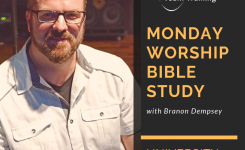Leaders, Podcasts / Devotionals, Worship Leading
Ashes, Ashes We All Fall Down (Worship of Holy Week)
 #3-23-16 #WorshipDevotional #HolyWeek It’s not just going to church, singing songs and listening to sermons.
#3-23-16 #WorshipDevotional #HolyWeek It’s not just going to church, singing songs and listening to sermons.
It’s discovering the greater reality of the work of God in pursuing man: Creation, Sending of Jesus, Suffering on the Cross, Resurrection into New Life, Sending the Holy Spirit, and His triumphant Return – all to deepen our worship and relationship with God the Father through Jesus Christ.
How does this Holy Week/Easter change your worship? We call this Holy Week because of what God the Father has done through the work of Jesus, His resurrection, Baptism by the Holy Spirit and the completed work of the New Covenant.
We are no longer children of the dark, nor ashes; we are children of the King and His light. Many people and Christians today, leave out the preceding Holy Week of Easter; it is here where we find a time of greater reflection, significance and meaning. Today, Lent and Holy week are not highlighted in mainstream contemporary times.
Good Friday usually means a day off from work, while Easter Sunday is about a bunny who leaves behind eggs. How does a bunny produce / or get their eggs anyway?
Lent signifies a period of preparation before Easter and is marked by Ash Wednesday, while it concludes with Holy Week: Palm Sunday begins our walk, next leading to Maunday Thursday, Good Friday, (Holy Saturday) and ending with Easter Sunday. Some suggest that Holy Week (Lenten Season) began around the second or fifth century.
Some of us may have learned about the Church Calendar and its history when we were children. As we become adults, we tend to leave behind elements from our past or heritage. The same is true of the Christian faith. We may learn great theology in the church from early Sunday school studies or classes, but later we often forget our learnings as we become distracted or fade into other “grown-up” responsibilities.
Learning heritage is not to be forgotten and is not for selected few. Some contemporary views in churches do not focus so much on the Old Testament, but rather the New Testament. But as we better understand how Old and New Testaments come together in completing the New Covenant (The Fulfillment of Christ), we will have a more enriched view and expression of worship, as our faith grows deeper in the appreciation of the Scriptures and our walk with Jesus.
Church history brings more meaning and significance to worship. More importantly, we develop a greater understanding in how and why we worship and praise God. Besides Good Friday and Easter, as a child, I’ve never had a clue about Ash Wednesday and Palm Sunday.
As I grew older my focus was more on the walk of Jesus, rather than the trail of candy by a bunny. In addition, what was this term Lent anyway (?), aside from something I found in the corner of my pockets. These terms may sound foreign to you as well.
My only memory as a kid was on Easter Sunday, unwrapping the fancy wrapped pieces of candy and pestering my younger sister. The meaning of ashes originated from the Old Testament, in which the Ancient Church used to symbolize repentance.
The significance of using ashes is derived from early church practices of burning palms from the previous Palm Sunday. Usually the pastor takes the ashes on the end of his thumb and makes a sign of the cross on the fore head of worshipers.
Yes, this happened way before the Catholic church. We use ashes because we identify ourselves to the dust of creation; we remember that we are dust, and it is God who breathed life into man. Genesis 3:19 says this, “remember man that you are dust and to dust you shall return.” These words remind us of our being and nature, as we recognize the status of man and the Holy status of Almighty God. [ctt template=”10″ link=”undefined” via=”no” ]Dust signifies a time to dedicate oneself to prayer, repentance, self-examination and renewal.[/ctt]
You see this personification every time through out the Bible when individuals have covered themselves in ashes and sackcloth in order to humble themselves (i.e. Mordecai, Isaiah, Jeremiah, Job and Daniel). We have a responsibility to learn, define, worship and highlight the essentials of these celebrations because they give us a deeper understanding of our relationship and worship of our Lord and the knowledge of his Word and the heritage of the Church.
We derive a greater appreciation and systemic in our understanding of what it means as sinful man being saved by holy God. True, most churches every Sunday, share this importance of a loving God saving sinful man. But during this season of Lent, we have a special opportunity to savor and experience these marked days of history when God miraculously brought man from death to life through Jesus Christ. 1 Corinthians 15:47: “The first man was of the dust of the earth; the second man is of heaven.” Romans 5:17: “For if, by the trespass of the one man, death reigned through that one man, how much more will those who receive God’s abundant provision of grace and of the gift of righteousness reign in life through the one man, Jesus Christ!” Romans 5:12: “Therefore, just as sin entered the world through one man, and death through sin, and in this way death came to all people, because all sinned-” We also walk with the Messiah, as together, we journey on the road to the cross, to His death and to His resurrection. Holy Week is a time to remember the journey.
IT is a time to reflect upon the carrying of our burdens and sin. We seek and find our need in Jesus as we morn His suffering yet rejoice in the resurrected life He will bring. For me, I never truly understood the impact of Holy Week until I began serving in a Lutheran church back in 2002. I served (and still serving) in many different Christian faiths.
The experience in this church is one that I would never trade, as I learned the deeper importance of acts of praise, worship, the Word and his loving relationship with man. As I dug deeper into the Word of God, doctrine and theology, it propelled me into an everlasting pursuit to understand the true biblical sense of worship.
I learned: the worship service in itself is not for you, to do cool songs and hear snappy messages, experience over-sensory media and the bells and whistles of other AV technologies.
All of these tools (and that’s what they are not our focus) are great, but how are they used in the context of a worship service in teaching and demonstrating who God is to our lost, broken and fragmented communities?
Finding words, prayers, songs and videos that relate to the Lenten Season/Holy Week (as well as Advent), we can speak of its importance in a relative way. In other words, as much as we declare the hope and salvation that Christ brings, we also need to examine why Christ came to save sinful man.
This brings us into a greater wonder and discovery of God’s deep love and the splendor of his mercy and grace.
When you think about it, we are like ashes; without Christ’s love and presence, our lives are meaningless, worthless, lonely, separated and disconnected. [ctt template=”10″ link=”undefined” via=”no” ]When we come into relationship with God through Jesus, we experience His kindness, nature and love.[/ctt]
We receive his grace, a welcome seat at the Table, an opportunity to share in the heavenly feast of God’s Fellowship and to bring with us others that they too, may partake in the life and family of Holy God. He truly has brought us beauty for ashes: “and provide for those who grieve in Zion— to bestow on them a crown of beauty instead of ashes, the oil of joy instead of mourning, and a garment of praise instead of a spirit of despair.
They will be called oaks of righteousness, a planting of the Lord for the display of his splendor.” Isa. 61.3 I encourage you during this season, to look into in the study, significance and the meaning of Holy Week. One book I recommend is by author Robert Webber, entitled Worship Old & New.
As you discover the impacts of the Early Church, important marks of history and significant events, discuss them with your pastor, share your learnings with your worship team, include your own family household and ultimately plant the seeds of truth in your worship services.
Many art forms can be used to illustrate and teach the season of Lent and meaning of Christ (i.e. 16th Century Church icons, stained glass and relics). Whether by message, visual art, film and/or music, it is essential to declare biblical texts that denote the time of preparation before Christ’s sacrifice.
May this Holy Week be filled with inspiration and wonder as God leads you into a deeper understanding of himself through worship, the Word, prayer, and communion as you respond to his mercy and grace.
As together, we later conclude on holy week, as one Body and one voice: Hallelujah, Christ has come, Christ is risen and Christ will come again! Amen! Through this Lenten/Easter season we cover ourselves with humility to reflect and examine of our need for God, while at the end we proclaim on Easter Sunday: “Alleluia, Christ has risen!
Christ will come Again!” Thus, we have a deeper sense, joy and adoration in celebrating our new lives in Christ: being buried with Him, being raised with Him and to live in faith, until His Second Coming. What songs, art forms and messages come to mind when you think about these truths?
How can you employ them in worship?
@BranonDempsey @worshiptt  Are you called to serve? Do you know your next step? How do you get to the next level? We can help. Learn more, so you can lead others. Discover what WTT Mentoring can do for you today: wttu.co/mentoring
Are you called to serve? Do you know your next step? How do you get to the next level? We can help. Learn more, so you can lead others. Discover what WTT Mentoring can do for you today: wttu.co/mentoring
Copyright 2017 Worship Team Training®









